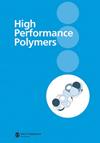从槲皮素中提取的生物基邻苯二甲腈树脂是一种可持续的分子支架:合成、固化反应以及与石油基同类产品的比较
IF 1.6
4区 化学
Q3 POLYMER SCIENCE
引用次数: 0
摘要
槲皮素(Q)是自然界中含量最丰富的分子之一,但在生物基热固性塑料领域仍相对缺乏开发。为了追求可持续发展,我们报告了利用槲皮素成功合成新型生物基邻苯二甲腈(PN)单体(Q-Ph)的情况。合成过程涉及 4-硝基邻苯二甲腈(4-NPN)的硝基置换反应。利用氢和碳核磁共振(1H 和 13C NMR)、傅立叶变换红外光谱(FTIR)和元素分析确认了单体的结构。利用差示扫描量热法(DSC)检测了固化特性,并利用傅立叶变换红外光谱分析了聚合情况。通过流变学分析,所得单体具有较宽的加工窗口和较低的熔体粘度。使用动态机械分析仪(DMA)和热重分析仪(TGA)对热性能和热机械性能进行了评估,结果显示,与石油基树脂相比,该树脂的固化和聚合温度更低。合成的树脂达到了超过 400°C 的高 Tg 值,1000°C 时的炭化率为 79%,T5% 和 T10% 值分别为 564°C 和 660°C。Q-Ph 聚合物表现出卓越的性能,并证明了一种自催化固化机制。这些结果突出表明,槲皮素是制备自固化 PN 热固性塑料的一种有前途的石化替代品,尤其适用于高性能应用。本文章由计算机程序翻译,如有差异,请以英文原文为准。
Bio-based phthalonitrile resin derived from quercetin as a sustainable molecular scaffold: Synthesis, curing reaction and comparison with petroleum-based counterparts
Quercetin (Q), one of the most abundant molecules in nature, remains relatively unexplored in the realm of bio-based thermosets. In line with the pursuit of sustainability, we report the successful synthesis of a novel bio-based phthalonitrile (PN) monomer (Q-Ph) using Q. The synthesis involved a nitro displacement reaction with 4-nitrophthalonitrile (4-NPN). Confirmation of the monomer’s structure utilized hydrogen and carbon nuclear magnetic resonances (1 H and 13 C NMR), Fourier transform infrared spectra (FTIR), and elemental analysis. Curing characteristics were examined by differential scanning calorimetry (DSC), and polymerization was analyzed using FTIR. The resulting monomers showed a wide processing window and low melt viscosity via rheological analysis. Thermal and thermomechanical properties were assessed using dynamic mechanical analyzer (DMA) and thermogravimetric analysis (TGA), revealing lower curing and polymerization temperatures compared to petroleum-based counterparts. The synthesized resin achieved a high Tg exceeding 400°C, a char yield of 79% at 1000°C, and T5% and T10% values of 564 and 660°C, respectively. The Q-Ph polymer demonstrated superior performance, with evidence of an autocatalytic curing mechanism. These results highlight quercetin as a promising petrochemical replacement for the preparation of self-curable PN thermosets, especially for high-performance applications.
求助全文
通过发布文献求助,成功后即可免费获取论文全文。
去求助
来源期刊

High Performance Polymers
化学-高分子科学
CiteScore
4.20
自引率
14.30%
发文量
106
审稿时长
1.2 months
期刊介绍:
Health Services Management Research (HSMR) is an authoritative international peer-reviewed journal which publishes theoretically and empirically rigorous research on questions of enduring interest to health-care organizations and systems throughout the world. Examining the real issues confronting health services management, it provides an independent view and cutting edge evidence-based research to guide policy-making and management decision-making. HSMR aims to be a forum serving an international community of academics and researchers on the one hand and healthcare managers, executives, policymakers and clinicians and all health professionals on the other. HSMR wants to make a substantial contribution to both research and managerial practice, with particular emphasis placed on publishing studies which offer actionable findings and on promoting knowledge mobilisation toward theoretical advances. All papers are expected to be of interest and relevance to an international audience. HSMR aims at enhance communication between academics and practitioners concerned with developing, implementing, and analysing health management issues, reforms and innovations primarily in European health systems and in all countries with developed health systems. Papers can report research undertaken in a single country, but they need to locate and explain their findings in an international context, and in international literature.
 求助内容:
求助内容: 应助结果提醒方式:
应助结果提醒方式:


